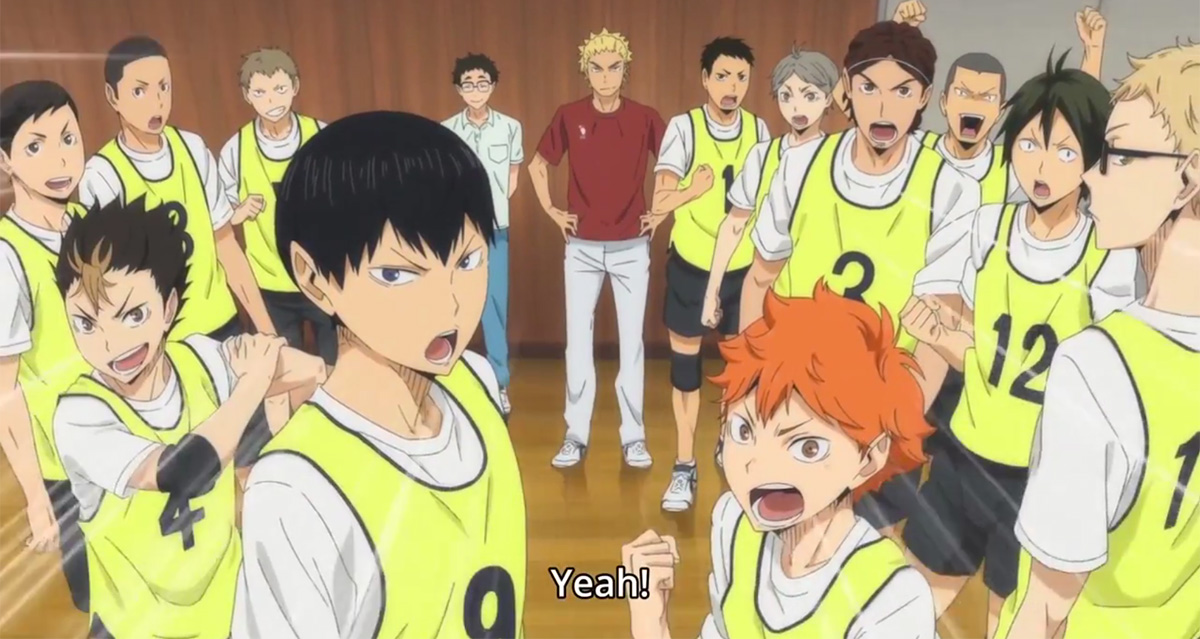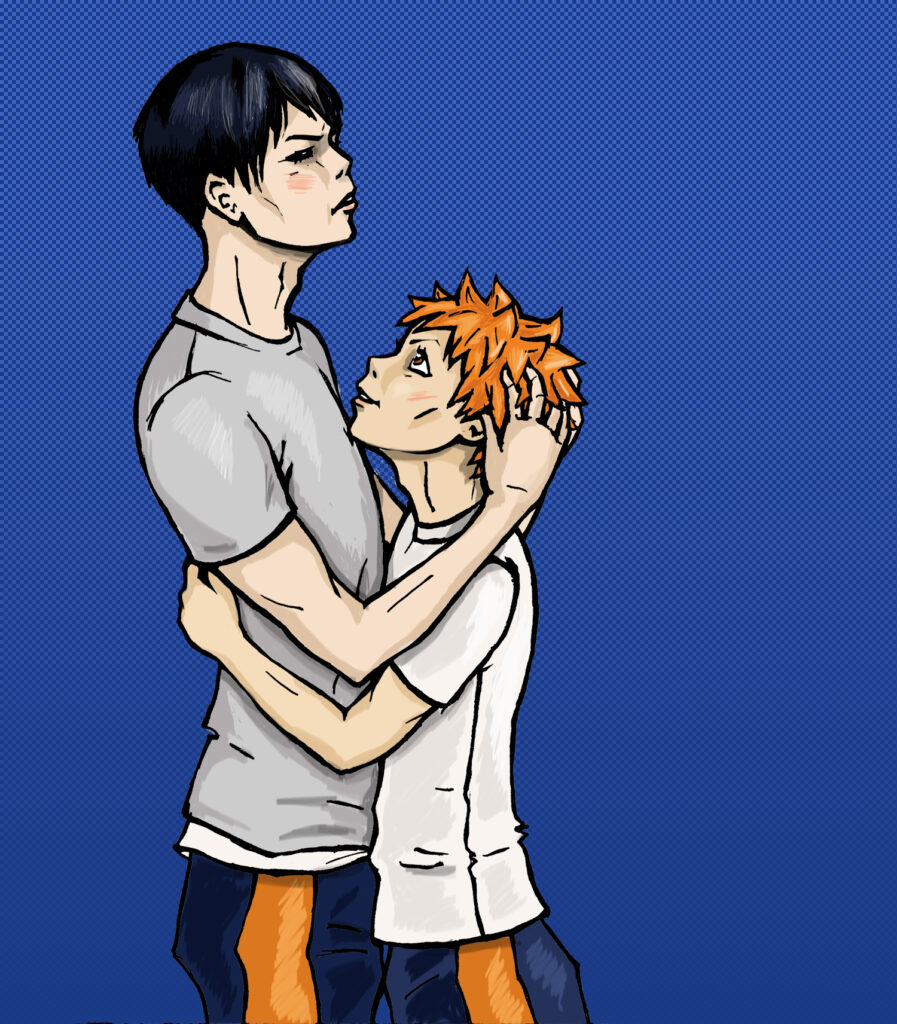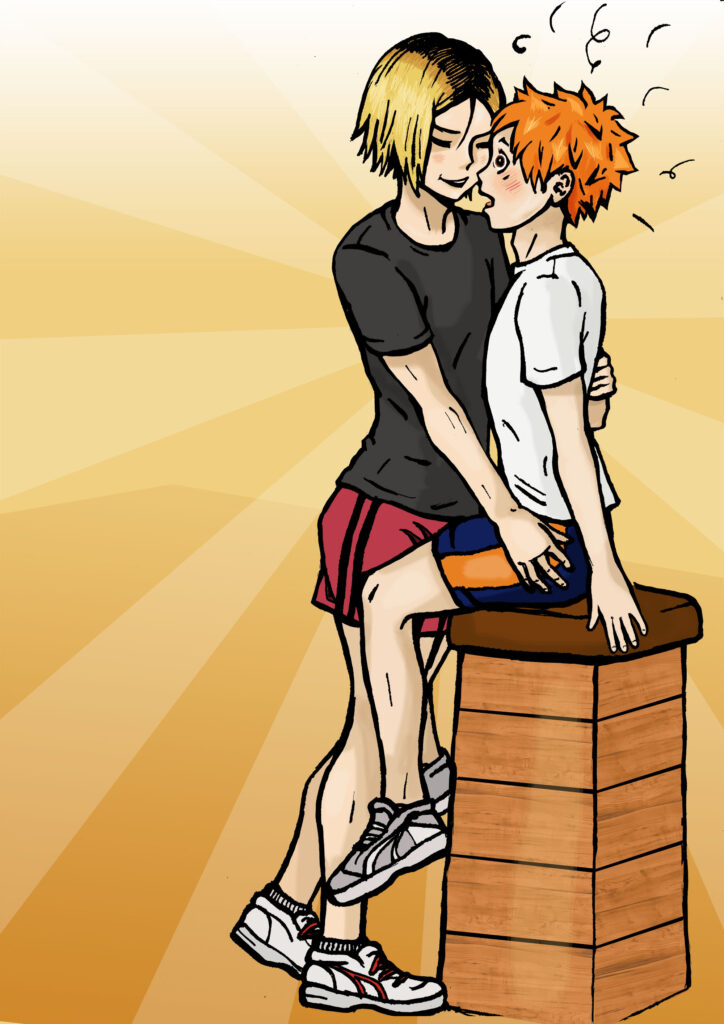
The fan art makes up for it!
In this text I will analyze fandom and fan creations connected to the shōnen (targeted towards boys) media franchise Haikyū!!. The text was originally written as a short assignment in the course Japanese Popular Culture Represented in Anime and Manga at Dalarna University.

Haikyū!! is originally a volleyball manga by Furudate Haruichi, serialized between 2012-2020 in weekly Shōnen Jump (My Anime List, 2020). The fourth season of the anime, To the Top, aired recently. Haikyū!! has a large following outside of Japan, and what I will be discussing are aspects of the english speaking fandom, which consists of people from all over the world.
Fan creations as playful communication
In the article How I Learned to Stop Worrying and Love being Otaku (Duffy, 2016) the author claims that the difference between otaku and maniacs is that otaku make the works they love into their own, by examining them thoroughly and building upon them. He writes that: ”According to Tamaki Saitō, ‘Being an otaku means being able to play around a little with the works you like; if you sanctify and worship them too much, you’ve fallen to the level of a mere maniac or fan.’” Secondary creations such as fan fiction, dōjinshi (fan comics), and AMV (anime music videos) could be seen as ways through which fans communicate with each other (Goosh, 2008) about the works/worlds that they love.
Shōnen for girls
It’s hard to find demographic data for the Haikyū!! franchise, but from browsing the fandom online I think it can be said to have a rather large following among teenage girls and young women. Some of the reasons might be traced to the phenomenon of ”shipping” (it can also be called slashing or pairing, but the term currently most used in this part of the fandom seems to be shipping). According to Wikipedia, the term “ship” is a short form of “relationship” and is used to describe the relationships, romantic or sexual, that fans make up between fictional (and sometimes real) characters. The word ship can be used both as a noun (a ship) and a verb (to ship). In the original works, those relationships are often described as friendships, but fans expand upon them and build community around specific ships.

Many of the fan creations within the Haikyū!! fandom revolve around shipping characters. Since the relationships are not described as romantic or sexual in the original works, those works can not be considered as BL (boys love), but the fans are making them into their own BL works. Ōtsuka (2010) describes the same phenomenon, then revolving around the soccer franchise Captain Tsubasa. Shipping male characters is mainly done by female fans (Hemmann, 2015), but not exlusively. Kris P Natz’ Youtube channel with the video series Boy Loves Boys Love is an example of when this phenomenon can involve queer audiences as well. And boy, does he do shipping: the video The 69 Best Haikyuu Ships (2020) is a list of his favorite ships from the Haikyū!! franchise.
Playing with content, expanding the world
Doing fan creations could be seen as creating small narratives within a grand narrative, or executing new programs based on the original code of the grand narrative, as proposed by Ōtsuka (2010) in his essay, World and Variation, originally written in 1989. The fan creations are narrative fragments, part of the grand narrative, but also existing in their own merit. But as a result of the development of the internet and the communication opportunities it offers, Azuma (2009) argues that the grand narrative has been shattered, and superseded by a database model of consumption. Whether you fully agree with that or not, it’s probably safe to say that narratives have become increasingly affected by and connected to cultural fragments from various sources.

The playful approach described by Duffy (2016) as a prerequisite for being otaku could also play a part as an element in fan creations. Playing is described as being free movement within a more rigid structure (Salen & Zimmermann, 2003). When stepping into the magic circle of play, the participants move freely within a world whose boundaries and rules they’re agreeing upon (Huizinga, 1938), but also continuously elaborating on. While creating new narratives, fans are both playing with each other and with the works themselves, by altering them to fit their preferences and seeing how other fans will react to their creations. The playful element can for example be seen in the Haikyū!! AMV:s based on the song There Right There from Legally Blonde The Musical (2007). According to Know Your Meme, this song has been used for AMV memes since 2008. There are many versions about Haikyū!! characters: Is Tsukishima Gay or European? Or is Oikawa Gay or European? Or might Kageyama be?
The database consumption model proposed by Azuma (2009) might be applicable here. Fans are connecting pieces of different narratives together, which bring meaning to them in this very specific context. If the work was shown to anyone outside of this part of the fandom, they might not understand much of it.
The fandom is what’s keeping me here
Sometimes the fandom and its secondary creations is what’s keeping the fans attached to a work, rather than the original content itself. The comments below are from Kris P Natz’ Youtube channel, where fans are discussing the latest season of Haikyū!!, which has been a disappointment to some fans, due to changes in the production.
“i think the new art style and the narrative of season 4 dented the show a bit for me personally but the fanart makes up for it.”
“It’s weird to say but I actually like the fandom more than the anime I don’t know why but I just do.”
For the fans speaking their minds here, the center of the fandom seems not necessarily to be the original work, but the world that is created around it, consisiting of the users’ communication and creations, as much as by the original creators’ narrative.

Bibliography and references
Azuma, Hiroki. Otaku: Japan’s Database Animals. Translated by Jonathan E. Abel and Shion Kono. Minneapolis: University of Minnesota Press, 2009.
Duffy, Rich. Tofugu, 2016. How I Learned to Stop Worrying and Love being Otaku.https://www.tofugu.com/japan/otaku-meaning/ . Accessed 1 Dec. 2020.
Goosh, Betsy. The Communication of Fan Culture: The Impact of New Media on Science Fiction and Fantasy Fandom. Georgia Institute of Technology, 2008.
Haikyuu!! My Anime List, 2020. https://myanimelist.net/manga/35243/Haikyuu . Accessed 1 Dec. 2020.
Haikyuu: Is Kageyama Gay or European? Youtube, 2017. https://www.youtube.com/watch?v=GFF8O3E95T4 . Accessed 1 Dec. 2020.
Hemmann, Kathryn. Queering the Media Mix: The Female Gaze in Japanese Fan Comics. Transformative Works and Cultures, no. 20. 2015.
Huizinga, Johann. Den lekande människan (Homo Ludens). Natur och Kultur, 1938.
I Have A Haikyuu Confession… (Haikyuu!! To The Top Season 2) | 3 Episode Ruling. Youtube, 2020. https://www.youtube.com/watch?v=Fpgrc20qGFc . Accessed 1 Dec. 2020.
Is Tsukishima Gay or European? Youtube, 2019. https://www.youtube.com/watch?v=8FfuZ5TQZvk . Accessed 1 Dec. 2020.
Gay or European? Know Yor Meme, 2020. https://knowyourmeme.com/memes/gay-or-european . Accessed 1 Dec. 2020.
Kris P Natz. Youtube, 2020. https://www.youtube.com/channel/UCHoOsT-1JOq6b4_b7V1JQZQ/videos . Accessed 1 Dec. 2020.
Oikawa Tooru – Gay or European? Youtube, 2015. https://www.youtube.com/watch?v=ouJZF3YMSdA . Accessed 1 Dec. 2020.
O’Keefe, Laurence and Nell Benjamin. ”There Right There”. Legally Blonde The Musical, Ghostlike Records, 2007.
Ōtsuka, Eiji. World and Variation: The Reproduction and Consumption of Narrative. Translated by Marc Steinberg. In Mechademia 5: Fanthropologies, edited by Frenchy Lunning, 99–116. Minneapolis: University of Minnesota Press, 2010.
Salen, Katie, and Eric Zimmerman. Rules of Play: Game Design Fundamentals. The MIT Press, 2003.
Shipping (fandom). Wikipedia, 2020. https://en.wikipedia.org/wiki/Shipping_(fandom) . Accessed 1 Dec. 2020.
The 69 Best Haikyuu Ships – Haikyuu!!’s (to the) Top OTPs | OTP Series. Youtube, 2020. https://www.youtube.com/watch?v=A430Bqz3nKU . Accessed 1 Dec. 2020.
1 Comment
Comments are closed.

Pingback: Making sports into drama (and games?) – Transcenders Media